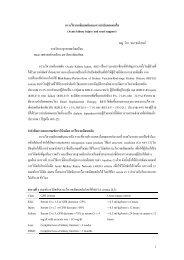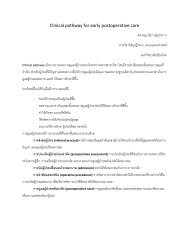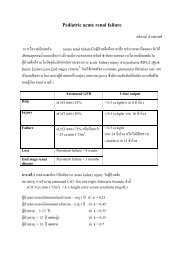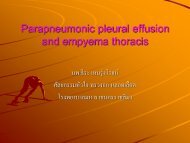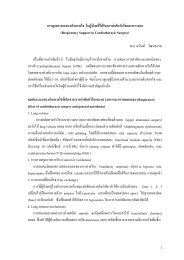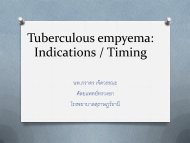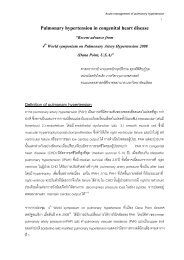Endovascular Repair of Descending Thoracic Aorta ... - TeraRecon
Endovascular Repair of Descending Thoracic Aorta ... - TeraRecon
Endovascular Repair of Descending Thoracic Aorta ... - TeraRecon
You also want an ePaper? Increase the reach of your titles
YUMPU automatically turns print PDFs into web optimized ePapers that Google loves.
<strong>Endovascular</strong> <strong>Repair</strong> <strong>of</strong> <strong>Descending</strong> <strong>Thoracic</strong> <strong>Aorta</strong> AneurysmRoy K. Greenberg, MDDirector <strong>of</strong> <strong>Endovascular</strong> ResearchDepartments <strong>of</strong> Vascular Surgery,CardiothoracicSurgery and Biomedical EngineeringKate Pfaff, BSCorresponding author:Roy K. Greenberg, MDDepartment <strong>of</strong> Vascular SurgeryThe Cleveland Clinic9500 Euclid Ave.Cleveland, Ohio 44195Email: greenbr@ccf.orgProgram Manager, Biomedical EngineeringCleveland Clinic, Cleveland, OhioIntroductionAdvances in image acquisition and reconstructiontechnology have paralleled the development<strong>of</strong> endovascular devices. Of particularinterest is the application <strong>of</strong> endovascular grafts tothe treatment <strong>of</strong> aortic aneurysms. Prior publicationshave defined the feasibility <strong>of</strong> the use <strong>of</strong> customizeddevices to treat aneurysms abutting or involving thevisceral vessels. To discuss this technology further,we will describe the use <strong>of</strong> sophisticated imagingtechniques to plan procedures to treat aneurysms <strong>of</strong>the descending thoracic aorta. Although this regiondoes not have branch vessels <strong>of</strong> large diameter, theinherent tortuosity, larger aortic diameter, and variedetiology <strong>of</strong> diseases underscores the need for comprehensiveevaluation <strong>of</strong> the aortic pathology combinedwith careful procedure planning and device sizing.The follow-up <strong>of</strong> patients treated with thoracic endovasculargrafts is also critical and requires preciseimage assessment using similar techniques.Classification <strong>of</strong> <strong>Thoracic</strong> Aortic DiseasesThe descending thoracic aorta (DTA) extends fromthe left subclavian artery to the level <strong>of</strong> the aortichiatus in the diaphragm, although many consider theportion <strong>of</strong> the abdominal aorta proximal to the celiacartery origin also to be part <strong>of</strong> the descendingthoracic aorta. Aneurysms are defined as an aortictransverse diameter exceeding twice the normal surroundingaortic diameter. Although aneurysms aredefined on the basis <strong>of</strong> diameter measurements, thereis considerable lengthening <strong>of</strong> the diseased segmentas well. Most aneurysms are considered non-specificin nature, implying that we do not fully understandthe pathogenesis <strong>of</strong> this disease. Several theories exist,and experts cite many causative factors includinggenetic predisposition, atherosclerosis, hypertension,remote infections, and smoking. However, notall aneurysms are non-specific in nature. Aneurysmscan be saccular (Figure 1) or fusiform (Figure 2) innature, the latter being more diffuse, frequently affectingthe entire DTA.<strong>Endovascular</strong> <strong>Repair</strong> <strong>of</strong> <strong>Descending</strong> <strong>Thoracic</strong> <strong>Aorta</strong> Aneurysm Roy K. Greenberg, MD and Kate Pfaff, BS123
Figure 1: Saccular aneurysm <strong>of</strong> the thoracic aortaFigure 2: Fusiform aneurysm <strong>of</strong> the thoracic aortaDissections are the second most common cause <strong>of</strong>thoracic aortic dilation (Figure 3). These occur whenthere is a tear in the intima <strong>of</strong> the aorta extendinginto the media (typically just distal to the left subclavianartery). This split in the aortic wall tends topropagate distally, frequently involving the abdominalaorta, the visceral and iliac vessels. The observedflap within an aortic lumen is characteristic <strong>of</strong> a dissection,which is managed differently than a nonspecificaneurysm (Figure 3).Other less common conditions exist that are frequentlyconfused with aortic dissections. These includeintramural hematomas and ruptured aortic plaques,but are pathologically distinct entities. Additionalpathologies that afflict the thoracic aorta must alsobe considered, including inflammatory diseases, autoimmunediseases, sarcoma and trauma. Therefore,it is important to define the etiology <strong>of</strong> the aorticdisease prior to treatment. This is best accomplishedusing a variety <strong>of</strong> image reconstruction techniquesthat are common to the Aquarius Workstation. Forthe purpose <strong>of</strong> this article, we will limit most <strong>of</strong> thediscussion to non-specific aneurysms.Figure 3: Green arrow depicts Type B thoracic aortadissection, beginning distal to the left subclavian arteryand continuing to abdominal aorta.124 SECTION 3 Surgical and <strong>Endovascular</strong> Procedure Planning
AnatomyThe descending thoracic aorta is bounded on oneside by the brachiocephalic vessels (innominate, leftcarotid and left subclavian arteries) (Figure 4), andthe abdominal visceral segment distally. Most aneurysms<strong>of</strong> the DTA involve the proximal segment,near the brachiocephalic vessels. This region is tortuousand has a diameter typically between 18 and30 mm. Anatomic anomalies exist, such as aberrantright subclavian arteries, vertebral arteries arising directlyfrom the aorta, and more complex situationssuch as nutcracker aortas (where the aorta is splitand traverses anterior and posterior to the esophagus)that are beyond the scope <strong>of</strong> this summary, butmust be defined prior to the endovascular treatment<strong>of</strong> aneurysmal disease.<strong>Endovascular</strong> devices should be fixated and sealedwithin healthy aorta. Thus, the importance <strong>of</strong> assessingthe regions immediately proximal and distalto the aneurysmal segment (the neck) is critical.Healthy aorta is typically cylindrical, free <strong>of</strong> debrisalong the wall, and not dilated. <strong>Endovascular</strong> devicestypically require 2-3 cm <strong>of</strong> non-aneurysmal proximaland distal aortic neck. The diameter <strong>of</strong> the nativeaorta is measured such that the implant devicediameter can be calculated by oversizing the aortaby 15-20%. Determining the length <strong>of</strong> the aorta tobe covered using the center line <strong>of</strong> flow is necessaryto select the length and number <strong>of</strong> components to beimplanted. Most devices are have a maximum length<strong>of</strong> about 20 centimeters; thus if the aneurysm properis longer than 15 centimeters, consideration must begiven to using multiple devices. Of particular interestis the morphology <strong>of</strong> the sealing and fixation zones.This has implications as to how the proximal and distalstents will reside along the wall. The overall tortuosity<strong>of</strong> the aorta will determine whether a deliverysystem can be readily advanced (extreme tortuositywill preclude most device deliveries), and the morphology<strong>of</strong> the iliac access vessels will predict wheredevices may be introduced into the arterial system(femoral versus iliac approach).Figure 4: Vessels <strong>of</strong> Aortic ArchCAVEAT: Preoperative CT data acquisition must includecomprehensive imaging <strong>of</strong> the thoracic aorta,brachiocephalic vessels, and abdominopelvic vasculature.Precontrast images should be obtained tohighlight regions <strong>of</strong> calcification. High-resolutionstudies are optimal with properly timed contrastboluses allowing opacification <strong>of</strong> the aorta and theproximal portion <strong>of</strong> all branches. Data should be reconstructedwith a smoothing algorithm.<strong>Endovascular</strong> <strong>Repair</strong> <strong>of</strong> <strong>Descending</strong> <strong>Thoracic</strong> <strong>Aorta</strong> Aneurysm Roy K. Greenberg, MD and Kate Pfaff, BS125
Figure 5: Evaluating vasculature by slicing volumetric datathrough different planes on the Aquarius WorkstationConsiderations to Planning and SizingThe complexity <strong>of</strong> defining limits <strong>of</strong> healthy tissue inthe thoracic aorta is similar to challenges in the abdominalaortic neck with additional considerations.In a population where prior aortic aneurysm repairis not uncommon, concerns <strong>of</strong> postoperative neuromusculardeficit are very real. Aortic tortuosity precludesthe use <strong>of</strong> thin slice axial CT images for theassessment <strong>of</strong> the region to be treated. Cross sectionalimages obtained from high-resolution spiral CTscans and reconstructed on a 3D workstation allowclinicians to evaluate these images using MPRs orthin MIPs. “Slicing through” data in axial, coronaland sagittal planes demonstrates the relationship betweenvascular and other structures, improving theevaluation <strong>of</strong> a patient’s disease process compared toevaluating axial images alone (Figure 5).126 SECTION 3 Surgical and <strong>Endovascular</strong> Procedure Planning
Figure 6: 3D reconstruction demonstrates conicalneck distal to curvature in aorta; therefore, the entireproximal fixation (2 – 3cm) must be planned to lieproximal to green arrow.Figure 7A: Grayscale volume-rendered image showingdistal conical neck. The distal fixation in this patientshould be planned to lie distal to the green arrow, therebyinvolving the visceral arteries in the repair.Given that the aorta should fundamentally decreasein diameter as blood travels distally from the leftventricle, unhealthy aorta can be simply defined asany region <strong>of</strong> increased diameter. Regions that appearconical on a straightened view are prototypical<strong>of</strong> aortic pathology that is frequently missed whentwo-dimensional studies are used in isolation to assessthe disease (Figures 6 and 7).Figure 7B: MIP post stentgraft. Red arrow shows distalleak. Yellow arrow identifies component <strong>of</strong> stentgraftabutting the celiac artery.Figure 7C: MIP after placement <strong>of</strong> a distal extension witha scallop to maintain distal patency <strong>of</strong> the celiac artery(yellow arrow).<strong>Endovascular</strong> <strong>Repair</strong> <strong>of</strong> <strong>Descending</strong> <strong>Thoracic</strong> <strong>Aorta</strong> Aneurysm Roy K. Greenberg, MD and Kate Pfaff, BS127
Figure 8 Figure 9 Figure 10Figures 8-10: Using the center line <strong>of</strong> flow (CLF) tool to create a straightened image <strong>of</strong> the aortaThus, the limits <strong>of</strong> coverage must be defined usingCLF (center line <strong>of</strong> flow) techniques, during whichaccurate diameter measurements <strong>of</strong> the regions canbe obtained. Using the vessel analysis tools on the3D Aquarius Workstation, a center line <strong>of</strong> flow iscreated by placing “seed points” at the proximal anddistal areas <strong>of</strong> interest (Figure 8). The informationthen generates a straightened image <strong>of</strong> the aorta (Figures9 and 10). This vessel analysis tool additionallyenables the physician the option <strong>of</strong> manipulating thecenter line <strong>of</strong> flow in order to simulate the path towhich the stentgraft may conform. Orthogonal slicesthrough the center line <strong>of</strong> flow provide measurementsthat are then used for endograft sizing (Figure 11).Figure 11: Measurements on the straightened aorta for endograft sizing128 SECTION 3 Surgical and <strong>Endovascular</strong> Procedure Planning
Tapered <strong>Aorta</strong>sUnder normal circumstances, the diameters <strong>of</strong> theproximal and distal DTA are not markedly different.However, it is not uncommon to have marked differencesin the setting <strong>of</strong> aortic pathologies. In this situation,when the proximal and distal DTA diametersdiffer by more than 5 mm, using a tapered deviceshould be considered. Such a device is designed tobe 15-20% oversized at the region <strong>of</strong> the proximalseal and distal seal, rather than compromising the designon one or the other seals. This occurs frequentlywhen a patient has had prior surgery that involves theplacement <strong>of</strong> a graft within the proximal (such as anelephant trunk graft) or distal DTA. Currently, thereare no commercially available tapered devices totreat thoracic aortic pathology in the United States;however, both the Zenith (Cook, Inc.) and Talent(Medtronic) are accumulating data on such designs.The Proximal Landing ZoneIt is critical that thoracic devices remain fixed in positionand continue to exclude the aneurysm for theduration <strong>of</strong> the patient’s life. Thus, the proximal sealingzone within the aorta must be carefully chosen.This decision is based primarily on aortic diameter,angulation, tortuosity, calcification, and branches.Aneurysms involving the proximal DTA can be particularlychallenging with respect to the proximallanding zone. The intended location <strong>of</strong> the sealingis most frequently near the left subclavian artery,which is more properly considered the distal aorticarch. This region has inherent tortuosity, forcing thestent to lie upon a lesser (inferior) arch curvature, andappose the greater curvature (superior aspect) <strong>of</strong> thearch along which the origins <strong>of</strong> the brachiocephalicvessels arise. This is a treacherous region for a stentwith any rigidity. In fact, almost all <strong>of</strong> the deviceswhen deployed will tend to project along the lessercurvature into the aortic lumen. Although there arepotential device designs that will prevent this, themost readily available solution for the interventionalistis to deploy the device in a non-tortuous region.That means deploying distal to the curvature if theproximal DTA is healthy. However, if the proximalDTA is diseased, then a deployment that will coverthe origin <strong>of</strong> the subclavian artery must be considered.This decision should be made during the designand planning phase <strong>of</strong> the procedure. Regardless <strong>of</strong>the landing zone location, the aortic diameter (outerwall to outer wall) should be assessed orthogonal tothe center line <strong>of</strong> flow, and the device oversized by15-20%. The tortuosity <strong>of</strong> the arch and status <strong>of</strong> theproximal DTA should be accurately assessed fromthe preoperative images to establish an operativeplan. Failure to do so will relegate the interventionalistto undesirable outcomes including more complicatedprocedures, the frequent use <strong>of</strong> proximalextensions, excessive manipulation or ballooning inthe arch, and longer procedure times.The Distal Landing ZoneIn most circumstances, the distal landing zone issimpler to deal with than the proximal landing zone.However, it is important not to underestimate thepotential for tortuosity within the distal aorta, particularlyas the aorta traverses the left chest to resideupon the anterior aspect <strong>of</strong> the spine in the region<strong>of</strong> the diaphragmatic hiatus. Many <strong>of</strong> the same concernsexist for this region. The operator must delineatethe distal margin <strong>of</strong> the aneurysmal disease, andmeasure the length and diameter <strong>of</strong> the distal fixationand sealing zone. The distal device diameter is oversizedby 15-20% in a manner similar to the proximaldevice diameter calculation.Length <strong>of</strong> Aortic CoverageThe distance between the proximal and distal landingzones delineates the required length <strong>of</strong> aorticcoverage. Although it may be appealing to simplycover the entire DTA, one must be cautious <strong>of</strong> therisk <strong>of</strong> paraplegia, which has been linked to the extent<strong>of</strong> aortic tissue lined with the endovascular graft.In general, if the amount <strong>of</strong> coverage is 12 cm orless, a single piece design can be considered. Theactual length is a simple calculation based upon theCLF, and most devices have prefabricated deviceswith lengths in increments <strong>of</strong> 2-5 cm that will suffice.However, most commonly the diseased segment<strong>of</strong> aorta is in excess <strong>of</strong> 12 cm and will require twoor more pieces to achieve an optimal result. In thesecircumstances, there will be an overlap region. Theimportance <strong>of</strong> a proper design for this region cannotbe overstated. Morphologic changes <strong>of</strong> the DTAand the endograft over time will result in componentseparation and sac repressurization if an adequateoverlap between components is not planned.<strong>Endovascular</strong> <strong>Repair</strong> <strong>of</strong> <strong>Descending</strong> <strong>Thoracic</strong> <strong>Aorta</strong> Aneurysm Roy K. Greenberg, MD and Kate Pfaff, BS129
The overlap region between the devices should beplanned such that it resides in a relatively straightsegment if possible and within the aneurysm proper.A simple way to design devices requiring two componentsis to plan the first (proximal) piece so that itextends from the origin <strong>of</strong> the proximal landing zoneto just above the distal margin <strong>of</strong> the aneurysm. Thesecond (distal) component extends from the origin <strong>of</strong>the aneurysm through the distal landing zone. Thus,the entire aneurysm will then represent the region <strong>of</strong>overlap. Yet, given the sometimes excessive length <strong>of</strong>the DTA, a third piece may be required. This pieceshould be used to supplement the overlap zone ratherthan constitute the proximal or distal landing zone(Figure 12).Figure 13: 3D reconstruction <strong>of</strong> coarctation patient. Whitearrow is area <strong>of</strong> aortic stricture. The red arrow showssignificant collateral flow.Figure 12: Three-piece stentgraft design (red arrowsshow areas <strong>of</strong> overlap)Miscellaneous PathologiesAneurysms represent the most common manifestation<strong>of</strong> DTA disease; however, proper assessment <strong>of</strong>imaging data will allow for the recognition <strong>of</strong> otherpathology. Aortic coarctation (Figures 13 and 14) anddissection are treated using similar techniques withrespect to image manipulation, planning and sizing.Figure 14: 3D reconstruction <strong>of</strong> same patient postangioplastyand endovascular stentgraft placement distalto the subclavian artery.130 SECTION 3 Surgical and <strong>Endovascular</strong> Procedure Planning
Follow-up StudiesThe methods for analyzing migration in a patientwith an abdominal aortic device are insufficient whenapplied to a thoracic aortic device. A 3D scan isneeded to make an accurate observation <strong>of</strong> devicestability and device migration within the thoracicaorta since a significant portion <strong>of</strong> the aorta is orientedparallel to axial images as indicated by the redarrow (Figure 15).reference vessel (the celiac artery) and the distal aspect<strong>of</strong> the stentgraft is determined at various timepoints. Movement <strong>of</strong> the device in relation to thesereference vessels warrants further investigation. Inthis case, and in cases <strong>of</strong> aortic lengthening, attentionto the three-dimensional reconstructed image isrequired. Calcification patterns within the aortic wallthat exist in close proximity to the implanted deviceare used as reference points. If the device positionhas changed relative to nearby aortic wall patterns,migration must have occurred. However, all <strong>of</strong> thismust be considered in the context <strong>of</strong> the image resolutionat each stage. Not infrequently, careful imageassessment <strong>of</strong> the aortic wall will yield concrete evidencethat migration has occurred, as there exists animprint <strong>of</strong> the initial device position in addition to atraceable path <strong>of</strong> slippage.Figure 15: Volumetric image <strong>of</strong> the thoracic aorta. Redarrow indicates portion oriented parallel to axial images.The aorta will frequently remodel during the life <strong>of</strong>the patient following the placement <strong>of</strong> an endovasculargraft within the DTA. Consequently, the assessment<strong>of</strong> device stability is complicated followingendovascular repair. Historically, axial image tablepositions were used to determine migration <strong>of</strong> stentgraftswithin the aorta. However, a detailed analysisrecently published by O’Neill et al. illustratesthe complexity <strong>of</strong> the problem <strong>of</strong> follow-up andclearly mandates careful image manipulation using3D tools. In his study, the CLF distance measurementbetween the left common carotid and the celiacartery was used to assess aortic lengthening. In theabsence <strong>of</strong> aortic lengthening, the distance betweena reference vessel (such as the left common carotidorigin) and the proximal aspect <strong>of</strong> the graft is establishedshortly after implantation and during each follow-upvisit. Similarly, the distance between another<strong>Endovascular</strong> <strong>Repair</strong> <strong>of</strong> <strong>Descending</strong> <strong>Thoracic</strong> <strong>Aorta</strong> Aneurysm Roy K. Greenberg, MD and Kate Pfaff, BS131
Figure 16A: The blue line indicates area <strong>of</strong> overlapin a stentgraft with suspected barb fracture in twolocations. Closer inspection using this technologywith stent specific template clearly identifiesa fracture <strong>of</strong> both a “z” stent (red arrow) and alongitudinal nitenol wire (red circle).Figure 16B: Enlarging aneurysm <strong>of</strong> patient with stentgraftfracture.Device IntegrityIn addition to the relationship between the deviceand the aortic wall, the integrity <strong>of</strong> the device, anddevice intercomponent relationships can be readilyestablished using specific reconstruction techniques.Data reconstruction using an edge detection algorithm,rather than a smoothing algorithm, illustratesthe ability to detect fractures <strong>of</strong> the metallic devicecomponents (Figure 16 A, B).132 SECTION 3 Surgical and <strong>Endovascular</strong> Procedure Planning
Figure 17: Fixed surgical landmarks are surgical clips (red arrows) and pacing wire (denoted by white arrows)sutured to the distal end <strong>of</strong> previously placed elephant trunk. Figure on left is at time zero. Comparisons are made atfollow-up with respect to migration. This example is evidence that the same amount <strong>of</strong> overlap <strong>of</strong> stentgraft is in theelephant trunk at one year.The degree <strong>of</strong> overlap between components can be accuratelymeasured, and the relationship between thedevice and fixed surgical landmarks can also help toassess device movement during follow-up (Figure 17).Endoleak is also assessed during follow-up using thevascular side-by-side module <strong>of</strong> the Aquarius Workstation.A non-contrast and contrast CT scan arecompared to determine if a true endoleak is present,and its source (Figure 18).Figure 18: Endoleak confirmed comparing non-contrast scan on left with contrastscan on right at same table position.<strong>Endovascular</strong> <strong>Repair</strong> <strong>of</strong> <strong>Descending</strong> <strong>Thoracic</strong> <strong>Aorta</strong> Aneurysm Roy K. Greenberg, MD and Kate Pfaff, BS133
Conclusion<strong>Endovascular</strong> technology is expected to benefit thetreatment <strong>of</strong> aneurysmal disease in the chest morethan in the abdomen because <strong>of</strong> the higher morbidity<strong>of</strong> open thoracic aortic procedures. However, theassessment <strong>of</strong> long-term durability <strong>of</strong> the endovasculardescending thoracic aorta repair will requirecompliancy in patient follow-up and sophisticatedimaging techniques.References1. Greenberg. RL <strong>Endovascular</strong> aneurysm repair using branchedor fenestrated devices. Clinical Case Studies in the Third-Dimension, 2005, <strong>TeraRecon</strong>, pp. 205-2142. Svensson LG, Crawford ES. Cardiovascular and Vascular Disease<strong>of</strong> the <strong>Aorta</strong>. 1997 W.B. Saunders Company, p.29.3. Greenberg, RK. Abdominal aortic endografting: Fixation andsealing. J <strong>of</strong> American College <strong>of</strong> Surgeons, Vol 194 Jan. 20024. Kasirajan, K. Milner R, Chaik<strong>of</strong> E. Late complications <strong>of</strong> thoracicendografts. J Vasc Surgery 2006; 43(A) 94A-99A5. Greenberg, RK, O’Neill, S, Walker, E et al. <strong>Endovascular</strong> repair<strong>of</strong> thoracic aortic lesions with the Zenith TX1 and TX2 thoracicgrafts: Intermediate-term results. J. Vasc Surgery, April 2005; Vol41. Issue 4 p. 589-5966. Gravereaux EC, Faries PL, Burks JA, et al. Risk <strong>of</strong> spinal cordischemia after endograft repair <strong>of</strong> thoracic aortic aneurysm. JVasc Surg 2001; 34; 997-10037. Ishimary S, Endografting <strong>of</strong> the aortic arch, J Endovasc Therapy2004: 118. O’Neill S, Greenberg RK, Resch T, et al. An evaluation <strong>of</strong> centerline <strong>of</strong> flow measurement techniques to assess migration afterthoracic endovascular aneurysm repair. J Vasc Surg. 2006 Jun;43(6) 1103-10.134 SECTION 3 Surgical and <strong>Endovascular</strong> Procedure Planning






